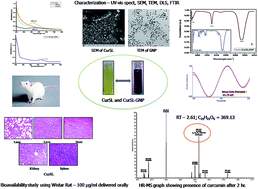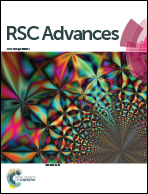Bioavailability studies of curcumin–sophorolipid nano-conjugates in the aqueous phase: role in the synthesis of uniform gold nanoparticles†
Abstract
The major limiting factors for curcumin to be accepted as a modern drug, despite its widespread applications, are its low aqueous solubility, low retention time and poor bioavailability. When subjected to a mild physical stress, curcumin is observed to internalize within the micellar hydrophobic core of oleic acid sophorolipid resulting in the formation of curcumin–sophorolipid nanoconjugates (CurSL). These bio-composites show enhanced retention time and increased bioavailability of curcumin in rat models. In the presence of gold salts, CurSL act as potent reducing and capping agents, resulting in the synthesis of monodispersed, spherical gold nanoparticles (CurSL–GNPs) of 8–10 nm in size. Physico-chemical, morphological and optical characteristics of both the nanoparticles are discussed based on spectroscopic absorption, photoluminescence (PL), dynamic light scattering (DLS), zeta potential, SEM and TEM measurements. FTIR spectroscopy signatures of these nanoparticles confirm the retention of functional groups in the end products. A retention time of 2 hours in blood plasma and an increase in curcumin recovery by about 150 times that previously reported were observed in the pharmacokinetic (pKa) studies performed on Wistar rats. The bio-distribution of gold nanoparticles in rats was studied using EDX, which revealed their presence in different vital organs. The absence of unusual legions or necrosis in histopathological analysis of vital organs in all the rat models suggests the use of curcumin–sophorolipid nano-conjugates enhances curcumin bioavailability and the Cur–SL based nano-gold formulation is a good drug delivery carrier.


 Please wait while we load your content...
Please wait while we load your content...